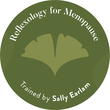Reflexology menopause support
A time to pause and reframe - what do you want to be for the next phase of your life - how can you achieve that?
Sally Earlam Reflexology About menopauseThe menopause/perimenopause is not an illness or but a natural transition that all women go through.
Perimenopause generally starts between the ages of 40 and 50 years. This is the first stage and occurs when hormones oestrogen and progesterone begin to fluctuate due to declining egg reserve in the ovaries. These changes in hormones are responsible for the worrying and sometimes confusing menopausal symptoms we experience, including hot flushes, fatigue, joint pain, anxiety, night sweats, mood swings and many, many more! The first symptom women usually notice is irregular periods. Menopause is the second stage and women are classed as moving from perimenopause to menopause after there has been no period for 12 months. It is important to look after our health at this time also as lowered oestrogen in the body increases the chance of developing certain long-term conditions such as heart disease, high blood pressure, high cholesterol, diabetes, stroke, some cancers, respiratory disease, osteoporosis, inflammatory conditions etc. The transition from perimenopause through to menopause takes 4 years on average. The three main hormones affected during peri/menopause are progesterone, oestrogen and testosterone. Hormones affect most parts of the body including the reproductive system, the brain, circulation, digestion, liver, kidneys, immune system, nerves, muscles etc. When the hormones are in balance the body systems work well together at their best. However, if one or more hormone is too high/low or missing it plays havoc on whole body and this explains the wide variation of menopausal symptoms women experience. LifestyleThe way we live our lives has a big impact on the way women experience menopause with women in non-industrialised cultures experiencing far fewer symptoms than women in western industrialised countries. This may be related to differences in lifestyle including:
Nutrition – as oestrogen levels fall, the body becomes less effective at breaking down carbohydrates, which can increase fat storage, and our metabolism also slows which makes it harder to lose weight. Changes in cholesterol levels occur with higher levels of bad cholesterol and lowering levels of good cholesterol. Exercise is believed to be one of the most important things that anyone can do to improve longevity and physical and emotional health. The British Menopause Society recommends regular weight bearing exercise e.g. walking, skipping, jogging, tennis. They also say to vary your exercise and to keep fit and flexible to reduce risk of falling e.g. Yoga, Tai Chi Managing stress levels - oestrogen and progesterone, our calming hormones, help protect us from cortisol (a stress hormone) so as oestrogen and progesterone come crashing down in menopause, the effects or cortisol are felt more and anxiety is a really common symptom. Getting good quality sleep - sleep disturbance is common and this is thought to be associated with falling hormones but is also affected by hot flushes or night sweats, anxious thoughts, less deep sleep and frequent urination which can all occur with reduced oestrogen levels. Progesterone has sleep-inducing effects on brain pathways which diminish in the menopause transition and also melatonin, which controls our sleep-wake cycles, decreases with age and can further disrupt sleep (1). Find enjoyment and purpose - although in the UK 80% of women do experience symptoms in perimenopause and menopause, it can also be a time for women to reframe their lives and to decide who they want to be for the rest of their lives. How can reflexology help?There are some studies showing that reflexology is beneficial for some menopausal symptoms (2,3,4).
However, everyone’s experience is very different and at your first appointment we will discuss the particular symptoms you are experiencing. This will allow me to plan reflexology specifically for you. I will offer non-judgemental listening and share knowledge about lifestyle changes if you would like to know more about this. The aim is for you to come away with improved physical and emotional wellbeing! How often should I have reflexology?As with all complementary therapies there is a cumulative effect so if you are able to have a few treatments close together you should see quicker results. It is recommended to have 4-6 treatments a week apart and then a couple fortnightly with the aim to continue with monthly treatments for top ups. However, this may not suit everyone and even monthly treatments can be beneficial.
References1. www.womens-health-concern.org/help-and-advice/factsheets/menopause-and-insomnia/
2. The effects of reflexology on sleep disorder in menopausal women. Maryam Asltoghiri, Zahra Ghodsi. Procedia - Social and Behavioral Sciences, Volume 31, 2012, Pages 242-246, https://www.sciencedirect.com/science/article/pii/S1877042811029788 3. The effects of reflexology applied to women aged between 40 and 60 on vasomotor complaints and quality of life. Gozuyesil E, Baser M. Complement Ther Clin Pract. 2016 Aug;24:78-85. https://pubmed.ncbi.nlm.nih.gov/27502805/ 4. The effects of reflexology on depression during menopause: A randomized controlled clinical trial. F Mahdavipour et al. Complementary Therapies in Medicine, Volume 47, 2019, https://pubmed.ncbi.nlm.nih.gov/31780002/ |

